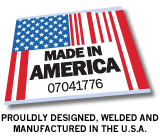 By: Kevin Loewen – Parts & People
By: Kevin Loewen – Parts & People
Cortland, N.Y.—What goes up must come down. And when what has gone up is a vehicle weighing thousands of pounds, making sure that the descent is controlled can be a matter of life and death, said Bob O’Gorman, President of the Automotive Lift Institute (ALI).
O’Gorman said the mission of ALI, founded in 1945, is “promoting the safe design, construction, installation, and use of automotive lift products.” In this role, the association has formed a lift certification program, a lifting guide safety manual and video, a lifting-points manual, and other tools to help the automotive service industry safely operate the hundreds of thousands of lifts that are used daily by the industry.
The association is made up of 19 member companies and one nonmember certification program participant, O’Gorman said. The companies, all North American, engineer, design, distribute, and service more than 80 percent of the lift equipment sold in North America.
The number of lifts used in the automotive industry has exploded in the past 20 years, O’Gorman said, and while the lift industry has a strong safety record, accidents do happen and can have catastrophic results both for the service technician and for the business that owns it.
“I’ve never met someone who wants to be injured or a responsible employer who accepts injuries as a cost of doing business,”O’Gorman said.
“If safety is a core value, I think every injury is preventable.”
The first step in ensuring safety is for shops to purchase lifts that have been certified to the American National Standards Institute ANSI/ALI ALCTV, O’Gorman said. This is already required under local building codes in the 47 states that have adopted the International Building Code, he said.
Even if a shop is not required by local code to have a certified lift, O’Gorman said it is important because it confirms that the lift has been tested to perform up to its listed specifications, for instance the amount of weight it is able to lift.
“There is a statement that has been around the lift industry for many years that I just hate,” he said. “‘Save a buck on hope and luck.’ In my opinion, that’s what shops that buy noncertified lifts are doing. I believe they are taking a tremendous risk.”
The next step, whether a business has existing lifts or has just installed new lifts, is to establish a planned service regimen, O’Gorman said. The American National Standards Institute ANSI/ALI ALOIM (Automotive Lift Operation Inspection and Maintenance) recommends that businesses follow the lift manufacturer’s recommendations for service and inspection or, in the absence of manufacturer information, follow the standard. he said.
O’Gorman said OSHA does not have its own regulations on lifts but instead uses ALI’s standards and can, therefore, under its General Duty Clause, cite shops for not performing planned maintenance. He said that in the case of a workplace accident or complaint, OSHA would inspect a shop’s equipment and records, and can also do that as part of a regular inspection.
While it is possible to handle inspections and service in house, O’Gorman said he suggests “leaving it to the pros,” either the manufacturer’s personnel or their distributors staff. “A shop owner needs to consider the liability factors and risk management factors of servicing and maintaining lifts in house,” he said.
ALI has also developed several products to help shop owners ensure that employees understand how to safely use a lift, O’Gorman said. In October, the association introduced a 24-minute lift safety DVD hosted by NASCAR legends Richard and Kyle Petty, he said. The DVD kit, in addition to the training video, contains the association’s safety manual and a written test that managers can have employees take to ensure they understand the safety information.
O’Gorman said the kit can be obtained through ALI for $79 or maybe available at a discount through lift manufacturers or other trade associations, such as the Tire Industry Association (TIA).
In recent years, ALI has developed a Strategic Safety Alliance program to help disseminate its safety materials. TIA and a several state autodealer associations have joined the program as have industry participants such as Bridgestone/Firestone. It has helped the issue of automotive lift safety training reach thousands of people, O’Gorman said.
In addition to the video, the association also offers the industry recognized “Vehicle Lifting Points Quick Reference Guide”, O’Gorman said. The guide includes manufacturers’ suggested lifting points, he said. Lifting at other points on the vehicle can result in vehicle damage, injury, or lift failure, he said. O’Gorman said ALI is happy to help shops interested in lift safety and encourages them to contact the association at 607-756-7775 or by visiting its Web site at www.autolift.org.


